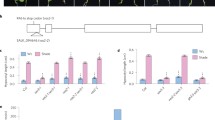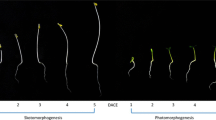Abstract
Cotyledons ofXanthium strumarium, organs with low sensitivity to photoperiodic treatment show a higher free indol-3-ylacetic acid level (by about 35 %) than the first pair leaves, organs with high sensitivity to photoperiodic treatment. This was seen in plants of three different age groups : A. with the first pair of leaves of 15–20 mm in length; B. with the first pair of leaves having finished their growth and C. with the third leaf of 30–40 mm in length.
Changes in free IAA level during the inductive dark period were similar in both cotyledons and leaves of the first pair. The level of IAA rose in the first half of the dark period, began to decrease in the latter half, reaching nearly initial level at its end.
Application of IAA (10−4 – 10−2M) to the cotyledons reduced their already low photoperiodic sensitivity resulting in inhibition of flowering (almost 70 % using 10−4M IAA).
Elevated free IAA level is assumed to be one of the causal factors of low photoperiodic sensitivity of cotyledons.
Similar content being viewed by others
References
Chailakhyan, M. Kh., Podolnyi, V. Z.: [Role of cotyledons in the juvenile period of plant development.] In Russ. -Fiziol. Rast.15: 949–957, 1968.
Eder, J., Rovenská, J., Kutáček, M., Čermák, V.: HPLC analysis of indole compounds inAgrobacterium and transformed tobacco cells. - In : Kutáček, M., Bandurski, R. S., Krekule, J. (ed.) : Physiology and Biochemistry of Auxins in Plants. (Proc. Int. Symp. Liblice, Czechoslovakia 1987.) Pp. 389–390. Academia, Praha; SPB Acad. Publ., The Hague 1988.
Jacobs, W. P.: The role of auxin in inductive phenomena. - Biol. Plant.27: 303–309,1985.
King, R. W., Cumming, B. G.: The role of phytochrome in photoperiodic time measurement and its relation to rhythmic timekeeping in the control of flowering inChenopodium rubrum. - Planta108 : 39–57,1972.
Krekule, J., Macháěková, I., Pavlova, L., Seidlová, F.: Hormonal signals in photoperiodic control of flower initiation. - In : Krekule, J., Seidlová, F. (ed.) : Signals in Plant Development. Pp. 145–162. SPB Acad. Publ., The Hague 1989.
Krekule, J., Pavlová, L., Součková, D., Macháčková, I.: Auxin in flowering of short-day and long-dayChenopodium species. - Biol. Plant.27: 310–317,1985.
Krekule, J., Přívratský, J.: An attempt to distinguish between inductive and postinductive effects of short-day plantsz. - Acta Univ. N. Copernici, Biol.18:45–51,1976.
Lang, A.: Auxins in flowering. - Encycl. Plant Physiol.14: 909–950,1961.
Macháčková, I., Krekule, J., Ullmann, J., Pavlová, L., Soucková, D.: Photoperiodic control of auxin and ethylene level in flowering inChenopodium sp. - In : Kutáček, M., Bandurski, R. S., Krekule, J. (ed.) : Physiology and Biochemistry of Auxins in Plants (Proc. Int. Symp. Liblice, Czechoslovakia 1987.) Pp. 319–323, Academia, Praha; SPB Acad. Publ., The Hague 1988.
Pavlová, L., Krekule, J.: Fluctuation of free IAA under inductive and non-inductive photoperiods inChenopodium rubrum. - Plant Growth Regul.2: 91–98,1984.
Podolnyi, V. Z., Chailakhyan, M. Kh.: [Inhibition of shoots flowering by coclebur cotyledons.] In Russ. - Fiziol. Rast.17 : 502–506,1970.
Podolnyi, V. Z., Khmelnitskaya, I. Ph., Chailakhyan, M. Kh.: [Ability ofXanthium strumarium cotyledons to induce proliferation of apical inflorescence.] In Russ. - Dokl. Akad. Nauk SSSR291: 765–769,1986.
Podolnyi, V. Z., Josefusová, Z., Khmelnitskaya, I. Ph., Verenchikov, S. P., Krekule, J., Chailakhyan, M. Kh.: Abscisic acid as a potent regulator of the transition from juvenile to mature stage inXanthium strumarium. - Biol. Plant.31:139–144,1989.
Robbins, W. J.: Gibberellic acid and reversal of adultHedera to juvenile state. - Amer. J. Bot.44 : 743–746,1957.
Seidlová, F., Khatoon, S.: Effects of indol-3-yl-acetic acid on floral induction and apical differentiation inChenopodium rubrum L. - Ann. Bot.40: 37–42,1976.
Simmonds, J.: IAA inhibition ofin vitro flowering of the short-day plantStreptocarpus nobilis. An effect on maintenance of induction. - J. Plant Physiol.131:191–199,1987.
Yang, S. F., Hoffman, N. E.: Ethylene biosynthesis and its regulation in higher plants. - Annu. Rev. Plant Physiol.35: 155–189,1984.
Author information
Authors and Affiliations
Rights and permissions
About this article
Cite this article
Podolnyi, V.Z., Macháčková, I., Josefusová-Vondráková, Z. et al. The role of indol-3-ylacetic acid in regulation of juvenility inXanthium strumarium L.. Biol Plant 33, 26–31 (1991). https://doi.org/10.1007/BF02873784
Received:
Accepted:
Issue Date:
DOI: https://doi.org/10.1007/BF02873784




